Both Waxy and Delicious: Crayon Physics
Petri Purho’s Crayon Physics, like the previously-reviewed Pluto Strikes Back, was created as part of his ongoing Kloonigames experimental game project. Purho tries to put out a new game each month, allowing himself no more than seven days to create each. Crayon Physics was done in five. As a bare-bones prototype, it doesn’t quite have the depth of a finished title. It compensates for a lack of polish with a layer of kindergarten charm and a loop of soothing licensed music. As a proof of concept, the game plays fine.
So what’s the concept?
Drawing Physical Objects
Each of the game’s drawing paper screens contains one or more bouncing yellow stars and a small ball of red crayon wax. The puzzle is solved when the ball has touched each of the stars. Obstacles and contraptions – walls, see-saws, bottomless pits – are sketched onto the path in bright, primary crayon colors. But the player can draw too.
Anything the player scrawls with the mouse on the drawing paper screen is instantly imbued with weight and volume. Draw a box in the sky and it plummets to the ground. Draw one over a see-saw, and it sends what’s on the other end into the air. A well-placed block will flip the ball over the see-saw and to its destination. Solve physical problems by drawing objects into existence: that’s the premise of Purho’s prototype.
You Can Draw Anything You Want, as Long as it’s Square
Unfortunately, Purho’s five-day coding exercise just isn’t as robust as my imagination. Though I’m given this big canvas to draw on, I’m only allowed to sketch squares. Anything I draw, no matter what it looks like, will have the properties of a rectangle when brought to life by the game. A drawing that’s too far off the mark will simply be transformed into a perfect rectangle. It’s often unclear exactly what the dimensions of a new object will be, especially when trying to draw something long and thin.
The game would be much more interesting if it allowed me to draw a round ball and a slope to roll it down, but curves are beyond the game’s shape recognition. And while I can play with see-saws the game provides, sketching my own is out of the question. The ball just doesn’t have enough vertical motion – it doesn’t bounce – to do anything but bump the side of anything I draw. Interacting with the ball usually comes down to dropping a box on it and hoping it rolls in the right direction. It just seems like a sloppy and imprecise way of interacting with the world, especially considering my ability to draw right on the screen.
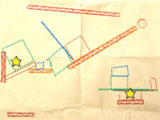
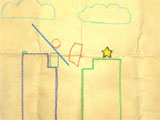
(Crayon Physics Game Screenshots)
Crayon Basics
Crayon Physics is a very limited game, despite a premise that calls to mind lots of possibilities. That’s because it was built as a prototype. It’s the most basic implementation of a drawing-based physics game, created to demonstrate how the concept might work. And what’s there does work – it’s playable from start to finish, if a little elementary. It’s also free and won’t take longer than fifteen minutes to play through. For anyone curious about what a game that combines physics with player-created shapes might look like, it’s time worth investing.
Download Crayon Physics (5.63 MB)
Visit Petri’s Kloonigames blog for more great experimental games.
Related Posts:
Turn-Based Pool Meets Rock-Paper-Scissors
I spent hours a day playing Globolus when I first discovered it. This was years ago, and a few friends and I got into it together. We would play dozens of matches every night. As our skills progressed, the complexity of our strategies would increase in an attempt to one-up each other. I remember the experience fondly. But then the game went to a premium business model, we grew tired of the few game modes available at the time, and soon we forgot all about Globoulos. Someone from the GlobZ team reminded me about the game recently, though, so I decided to check in on it. It turns out that there’s a ton of new stuff, but the classic–enjoyable, addicting–Globulos experience still remains.
Simple Controls
The controls in Globulos are a great example of the right kind of simplicity. The game is turn-based; during each turn both players set trajectories for their pieces. After the planning time, the round plays out simultaneously using a simple physics model. Globs bounce off each other and the environment as you would expect them to. In some modes, the goal is to push a puck into your opponent’s goal. In others, it’s to push their king–who can’t move under his own power–off the board. There are zanier modes, too, like darts, tic-tac-toe, or croquet.
Bluffs and Double-Bluffs
The brilliance of the gameplay comes from predicting your opponent’s moves. Most players start out with Globulos by making obvious, predictable moves. They’ll go right for the ball in a soccer game, or directly at the king in the sumo mode. Of course, predictable moves can be exploited. If you know where a piece will move you can intercept it to push it off the edge, or dodge it so it goes off the edge by itself. Naturally, the next step in the evolution of playing Globulos is the bluff. You might pass on a really obvious move in the hopes that your opponent will be expecting it. You’ll then design your play to exploit their response to the move you won’t be making. And, finally, the double-bluff: You expect your opponent is predicting you will bluff, so you do the obvious move anyway and hope they’re expecting you not to. Whew!
As you can see, things can get complicated. A typical situation usually results in trying to design a play that responds to multiple scenarios. You’ll want to cover the possibility of a bluff and a double-bluff all in the same setup. This is obviously very hard to do. The chain reaction of multiple globs colliding all in the same area can have very chaotic results.
Play With Friends!
The real fun of Globulos, for me, can only be had by playing the same people multiple times. When you keep playing the same person, you start to learn their style of play (and they start to learn yours). The interplay between trying to adapt to them, while they’re simultaneously trying to adapt to you, is what makes Globulos interesting. It’s like playing rock-paper-scissors. If you play stone five times in a row, obviously you won’t be playing it a sixth time. Or will you? That kind of gamble is thrilling, but it’s really only fun if you’re playing with people you know. I highly encourage everyone to set up Globulos games with friends. I played quite a bit with people in the same room when I first got into it, which was especially enjoying.
Free Version Available
Globulos is still using a split free/premium business model. You can play for free as a guest, with the following limitations: your session will end after 15 minutes, and you can only start games of certain type (which change regularly). The subscription has multiple price points which range for $2 for 7 days to $27 for 12 months of access.
Play Globulos Online (Flash required)
Personally, I would love to see more features available free of charge. I think they could still see revenue by limiting premium features to meta-game features like tournaments, special icons and names, and so on, without limiting too much of the gameplay experience. The game is old enough that perhaps they could go back to a completely free model, too, which would certainly see a surge of users. Still, you can play Globulos for free with the current system. Why aren’t you playing now?
Related Posts:
Drunken Ragdolls Fight for Our Amusement
Sumotori Dreams is a small demoscene game created by Peter Sotesz for the Breakpoint 2007 96k game competition (it took first). The premise is simple: two self-balancing physics rigs face off in a sumo ring. The first rig to fall over loses. The implementation is simple but satisfying, and is well supported by solid physics, decent lighting, and good camera work. You can play against a computer opponent, but the real fun is playing Sumotori against a friend on the same keyboard.
Technically Astounding
It’s worth mentioning that Sumotori is a technical masterpiece. Even ignoring its miniscule size, the physics engine stands alone as innovative. The destructible walls provide a great sense of impact. I spent a few minutes just destroying them in the game’s hidden mode (shoot between the right-most slat to destroy the near corner wall on the title screen). If you let the ragdoll men stagger around a bit after a match they’ll usually end up in the walls, too. It’s great fun to watch them smash things in their desperate attempt to right themselves.
How Does it Play?
The control system in Sumotori is once removed. The physics ragdoll rigs are self-balancing, so they’re in constant autonomous motion whenever they’re off balance (which is 100% of the time as soon as you engage your opponent). Even moving around is a little spastic–it looks like your input doesn’t control the rig directly, but rather nudges it off-balance. The actual locomotion is a product of the rig self-righting itself to compensate for the new imbalance.
As a result, it can be frustrating to play Sumotori. It’s especially punishing if your play style is aggressive. It seems more productive to do small, controller movements, or sometimes not move at all. The victors in many of our battles were simply the rig that fell second, even before the rigs were touching. Matches are over quickly; very few engagements lasted more than a push or two before one of the characters would completely lose its footing.
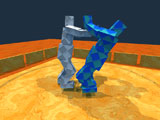
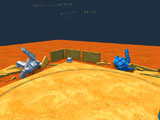
(Sumotori Dreams Game Screenshots)
Impressive Implementation
Sumotori is awfully impressive–self-balancing bipeds are a very difficult domain, even in the scope of “serious” research. Granted, a video game can tweak the rules of physics where a physical robot cannot, but it’s still a great achievement. I’d love to see Peter keep tweaking the physics to massage the gameplay to a more advanced state, but even now Sumotori is a fun party game. Plus, it’s only 87k and it’s completely free. Give it a try!
Download Sumotori Dreams Game (87 KB)]
Virus Info: Many scanners may report this as a generic trojan. It is not a virus; it simply makes use of esoteric API calls to be remain so small.
More information on Sumotori can be found at Peter’s official page.
Related Posts:
« Previous Page — Next Page »

 (Rate this game! 331 votes, average: 4.08 out of 5)
(Rate this game! 331 votes, average: 4.08 out of 5)
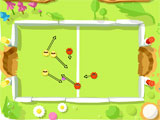
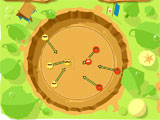
 My name is Matthew Wegner, and this site is dedicated to physics games.
My name is Matthew Wegner, and this site is dedicated to physics games.